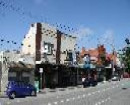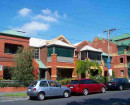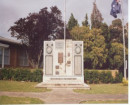CORK HILL
138 KITSON ROAD, CAPE BRIDGEWATER, GLENELG SHIRE
-
Add to tour
You must log in to do that.
-
Share
-
Shortlist place
You must log in to do that.
- Download report


Statement of Significance
Cork Hill is located about 200m west of Kittson's Road, on a slight rise overlooking the land towards Cape Bridgewater. The Cork Hill complex comprises two linked buildings, the earlier section which is a low stone cottage and the later section an Edwardian timber house. The low stone cottage is located at the rear of the Edwardian house, and is typical of the work of Joseph Black, the northern section being finely cut and laid stonework. The southern end of the cottage is of early timber construction, and retains its original wide hardwood floorboards, although they have recently been painted. This cottage, rectangular in plan, probably dates from the early 1850s when Joseph Black and his family arrived in the Bridgewater area and took up the land in what became Kittson's Road. Generally, the early stone and timber cottage has a very high degree of integrity, and is in fair condition. The Edwardian Timber house is linked to the early cottage, and sits in front of the cottage to the east of the site. The house is typical of its period, with a projecting gable at the front of the house and to the south section, otherwise the house is fairly standard in plan. The hipped roof is of corrugated iron, as are the roofs of the projecting gables. A number of later timber additions with corrugated iron roofs link the Edwardian House and the early cottage. No architect or builder has been associated with this timber house, but it is thought to have been built by Joseph Black's son, who lived there from his birth in 1865 until his death in 1936. The complex is sited on a rise, and has few plantings surviving. Those which do survive include an Araucaria heterophylla (Norfolk Island Pine) at the front of the house and a Ficus carica (Common Fig) adjacent to the eastern wall of the stone cottage. The timber Edwardian house is in very good condition and retains a very high degree of integrity.
How is it Significant?
Cork Hill is of historical and architectural significance to the Glenelg Shire.
Why is it Significant?
Cork Hill is of historical significance as one of the earliest surviving stone cottages which remains on the Cape, reflecting the struggle of Irish immigrants to apply their existing skills to a new land. Of further historical significance is the association with Joshua Black, who not only built the early timber and stone cottage, but a number of the fine stone buildings in Portland and Cape Bridgewater around the mid nineteenth century. The complex is of historical significance as it illustrates the typical standard forms of its time in the vernacular architecture. The cottage is typical of those built in the area in the 1840s and 1850s and the timber Edwardian house is typical of the 1910 period when it was constructed. Of further historical interest is the way that the architectural styles of different periods are able to be 'read' to tell the story of the Black family over more than 100 years of continuous occupation of the buildings.
-
-
CORK HILL - Usage/Former Usage
Continues as a private residence
CORK HILL - Physical Description 1
The Cork Hill complex comprises two linked buildings, the earlier section of which is a low stone cottage and the later section an Edwardian timber house. The low stone cottage is located at the rear of the Edwardian house, and is typical of the work of Joseph Black, the northern section being finely cut and laid stonework. The southern end of the cottage is of early timber construction, and retains its original wide hardwood floorboards, although they have recently been painted. This cottage, rectangular in plan, probably dates from the early 1850s when Joseph Black and his family arrived and took up the land in what became Kittson's Road. The larger stone portion of the building may originally have been divided into sections, but these have long since been removed, as have any floorboards. The roof is a simple hip and has been recently re-clad with Zincalume and coloured corrugated iron. Attached to the western wall of the cottage are a series of lean-tos with a single skillion corrugated iron roof. The date of these skillion additions is unknown, but likely to be about 1860-1880s. The addition closest to the stone section of the cottage has had a large opening made in the north wall to accommodate a vehicle. This portion of the building is used as a garage. Generally, the early stone and timber cottage has a very high degree of integrity, and is in fair condition.
The Edwardian Timber house is linked to the early cottage, and sits in front of the cottage to the east of the site. The house is typical of its period, with a projecting gable at the front of the house and to the south section, otherwise the house is fairly standard in plan. The hipped roof is of corrugated iron, as are the roofs of the projecting gables. A number of later timber additions with corrugated iron roofs link the Ewardian House and the early cottage. The complex is sited on a rise, and has few plantings surviving. Those which do survive include an Araucaria heterophylla (Norfolk Island Pine) at the front of the house and a Ficus carica (Common Fig) adjacent to the eastern wall of the stone cottage.CORK HILL - Physical Conditions
Very good overall
CORK HILL - Historical Australian Themes
2. PEOPLING AUSTRALIA
2.4: Migrating
2.4.2: Migrating to seek opportunity
2.4.4: Migrating through organised colonization
2.4.5: Changing the face of rural and urban Australia through migration
2.5: Promoting settlement
3. DEVELOPING LOCAL, REGIONAL AND NATIONAL ECONOMIES
3.5: Developing primary production
3.5.1: Grazing stock
3.5.2: Breeding animals
3.5.3: Developing agricultural industries
3.9: Farming for commercial profit
3.11: Altering the environment
3.11.4: Clearing vegetation
3.11.5: Establishing water supplies
3.12: Feeding people
3.12.2: Developing sources of fresh local produce
3.14: Developing an Australian engineering and construction industry
3.14.2: Using Australian materials in construction
3.16: Struggling with remoteness, hardship and failureHeritage Study and Grading
Glenelg - Glenelg Shire Heritage Study Part One
Author: Carlotta Kellaway, David Rhodes Mandy Jean
Year: 2002
Grading:Glenelg - Glenelg Heritage Study Stage Two (a)
Author: Heritage Matters
Year: 2006
Grading:
-
-
-
-
-
MT PLEASANT HOMESTEAD, KITTSON ROAD, CAPE BRIDGEWATER
 Victorian Heritage Inventory
Victorian Heritage Inventory -
KITTSON HOUSE, CAPE BRIDGEWATER
 Victorian Heritage Inventory
Victorian Heritage Inventory -
KITTSON CEMETERY, KITSON RD, CAPE BRIDGEWATER
 Victorian Heritage Inventory
Victorian Heritage Inventory
-
..esterville
 Yarra City
Yarra City -
1 Alfred Crescent
 Yarra City
Yarra City -
1 Barkly Street
 Yarra City
Yarra City
-
-









